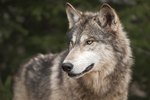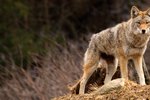
The word "wolf" describes three species that are part of the family Canidae, just like domestic dogs. Most notably, it refers to the gray wolf (Canis lupus), which roams North America and parts of Asia. Other species are the Ethiopian wolf (Canis simensis) and red wolf (Canis rufus). Wolves are strong communicators, according to Animal Bytes at San Diego Zoo. These social animals often rely on body language to communicate their feelings, including affection.
Nibbling
Despite their somewhat steely and intimidating exteriors, wolves actually can be loving animals. Wolves often show their affectionate and merry sides by gently nibbling on each others' faces. Although it may appear to outsiders as being hostile, the nibbling is a sign of endearment.
Social Grooming
Similar to many other types of animals, wolves frequently express their fondness through mutual grooming activities. By placing their tongues on each others' fur and extracting debris with their teeth, wolves establish rock solid connections. This kind of grooming is especially prevalent in male and female wolf pairs, before mating acts occur.
Whining
Fully mature female wolves also sometimes convey feelings of affection by making whining sounds. If you hear a whimpering wolf, she's not necessarily upset about anything.
Tactility
Wolf affection lies heavily in close tactility. By huddling up together and touching directly, wolves exchange positive feelings and make their bonds tighter. When a couple of wolves snuggle together in this manner, you may even notice one placing his head right on top of the other individual's neck.
Face Licking
In wolves, enthusiastic face licking not only is an indication of affection, but also sometimes one of subordination, too. If one wolf licks the face of another, he may be making a point to convey his lower social ranking. In the world of wolf packs, "superior" animals are generally the toughest and the ones with the most seniority.
Howling
If wolves have been separated from their packs for quite a while, they sometimes express their excitement and happiness about coming together again by producing a lot of noisy howling and yelping sounds.
References
- San Diego Zoo's Animal Bytes: Wolf
- University of Michigan Animal Diversity Web: Canis lupus
- National Geographic: Wolf
- University of Michigan Animal Diversity Web: Canis rufus
- International Wolf Center: Communication
- The Truth About Wolves & Dogs; Toni Shelbourne
- Wolf Haven International: Communication & Behavior
- Living With Wolves: Affection
- University of Michigan Animal Diversity Web: Canis simensis
Photo Credits
-
NA/AbleStock.com/Getty Images



